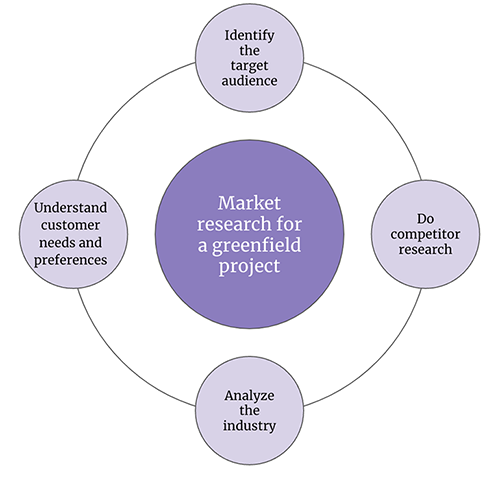Editor’s note: This article was updated on 21 November 2024 to include a more detailed comparison of greenfield vs. brownfield projects, provide a summary of greenfield project stages and their outcomes, and answer commonly asked questions about greenfield projects.

A greenfield project is essentially a project built from scratch without any constraints from previous projects. The word “greenfield” is used across many industries and originally comes from real estate, where it describes lands that are completely untouched by any previous construction.
In the software world, a greenfield project refers to a project that does not have any existing infrastructure or legacy systems. This kind of project offers a blank slate to all members of the project team, including engineers, product managers, designers, marketers, and sales personnel.
A greenfield project’s direct contrast is a brownfield project, which involves making improvements or modifications to the current project:
| Greenfield projects | Brownfield projects | |
|---|---|---|
| High-level description | Projects built from scratch without any existing constraints, infrastructure, or legacy systems from previous projects | Projects that build on existing projects and/or legacy systems, frameworks, or infrastructure |
| Benefits | – Room for innovation and new ideas – Lots of flexibility with no dependencies on any previous systems – Control over customization; tailored solutions to user needs and requirements |
– More cost-effective and time-effective – Ability to improve on existing foundations (data, user bases, processes) – Lower risk, since lessons from previous project successes and failures can apply |
| Challenges | – Higher risk; potential to go down the wrong path and develop a solution that doesn’t fit the target audience – Potentially expensive to build a new project from scratch – Lack of initial feedback from users and more uncertainties to face |
– Less flexible; existing systems or infrastructure may be too constraining – Less opportunity to innovate; not as much room for creative thinking or custom solutions |
| Examples | A new idea in an unexplored market, like Uber’s creation of an online taxi marketplace A new product or service from a company, like Netflix pivoting from mail-order DVD rental to online streaming |
Apple launching iPads that took iPhone features to a larger screen, or iterating on previous operating systems to launch more recent iOS versions with modifications to current features as well as newly added features |
It’s helpful to consider factors such as the project’s goal and how it fits into wider organizational goals, budgetary constraints, the level of risk tolerance, and general market conditions.
A greenfield project has five stages:

Let’s explain each stage in more detail below.
The hardest part of leading a greenfield project as a product manager is the kick-off and defining the initial project scope. Unlike a brownfield project, there is no starting point or reference. Should we start with engineering or design? What should the MVP be? How do we bring all the stakeholders together?
Here’s what I did as a product manager back when I led a greenfield project:
At the end of the month, we were able to come up with a plan. This plan included:
Market research is one of the most interesting phases of a greenfield project, primarily because there is no data readily available for the teams to work on. Unlike in a brownfield project, teams don’t have data to go off of and are starting from scratch.
This makes market research a bit more challenging. Here are a few ways to conduct market research and come up with insights that can help in the decision-making of a greenfield project:

A product roadmap helps teams get a clear understanding of what to deliver and when. In a greenfield project, this is an important tool to deliver solutions. Here are a few pointers that will help you, as a product manager, build an achievable product roadmap.
This is an extremely important part of the success of the product. There needs to be a balance of frontend engineers, backend engineers, and designers depending on the product. And understanding the team’s expertise, skills, and interests will help them have clarity of their responsibilities and foster strong communication and collaboration.
This part of the roadmap is particularly challenging because there are multiple variables and uncertainties involved in a greenfield project. This is why it’s important to understand the scope of the project and key milestones, come up with a realistic estimation of the work, and continuously review and adjust the timeline. It’s important to be agile for a greenfield project.
This is the backbone of the entire phase. Ideally, it should be connected with the bigger vision of the product and the problem it’s solving. There are multiple frameworks available to prioritize the features such as Kano, story mapping, the MoSCoW method, opportunity scoring, product tree, or cost of delay. There’s also the ability to come up with a new framework. The most important goal is to prioritize the features so the team can deliver the highest-value feature in the shortest available time.
The allocation of resources for a project requires having a strong understanding of the costs. And how do you estimate that? A few pointers to consider while estimating the cost of a resource are salaries, equipment costs, software licenses, training expenses, travel costs, and anything else that a team member would need to successfully participate. Use this information to create a realistic budget, include potential risks or uncertainties, and allow a buffer.
The logical next step after the allocation of resources and determining the budget is the implementation phase. This is where all the teams come together and start working on the project. For this to happen, you need to develop a project plan, manage the deliverable, and monitor the progress.
A project plan includes a timeline of the respective deliverables and who’s working on them. There are multiple tools available in the market for building this plan, such as Jira, Monday.com, Trello, and Zoho to name a few. This plan also helps to understand any dependencies that the project might have and acts as a single source of truth for everyone.
This is the phase where the teams work together to implement the deliverables. The product manager needs to have an overview of the status of every deliverable. One of the effective ways to do this is to schedule a daily 15-minute standup with the team to share updates and more importantly any blockers they are facing.
In case of blockers, the product manager needs to act on them quickly so that no team members are blocked and the project functions smoothly per the initial project plan. In case the blocker is not solved for some reason, the project plan should be updated and the details should be communicated to all the relevant stakeholders.
This is ideally the last part of a greenfield project, where the product is launched to customers. But only launching a product won’t help, there needs to be marketing of the product for the customers to get to know about it. There are multiple avenues for marketing, including word of mouth, paid advertising, and content marketing. It highly depends on what the product is.
Once the product is on the market, you will receive feedback. And it is important to understand the feedback to come up with improvements and modifications. This may involve making changes to the design, features, or marketing strategy.
Last but not least, as a product manager, it’s important to understand the scaling aspect of the product to meet market demand. Considering that there is positive feedback from the customers and they are willing to pay for the service, there should be a plan in place to scale the product to other customers. This will require continuous monitoring of the KPIs and insights from the data.
| Stage | Activity | Outcomes |
|---|---|---|
| 1. Kick-off / Defining the project scope | – Identify potential stakeholders and schedule regular check-ins with them – Define MVP – Define and assign tasks – Document progress |
– Clear project objective & timeline – Defined success criteria – Completed risk assessment |
| 2. Conducting market research | – Identify target audience – Collect data on needs and preferences – Perform competitor research and market analysis |
– User personas (defined target audience with needs and preferences) – Defined customer journey – Understanding of competitors and industry |
| 3. Building the product roadmap | – Understand the team’s expertise – Define team roles – Define project scope and timeline – Prioritize features and functionality – Allocate resources and budget |
– Clearly defined, achievable product roadmap – Breakdown of team roles and responsibilities – List of priorities – Realistic budget |
| 4. Implementing the project | – Develop project plan – Manage project deliverables – Monitor progress |
– Active progress towards project goal – Quick resolution of any blockers – Updated project plan |
| 5. Launching and scaling the product | – Launch product – Market to customers – Collect and analyze feedback – Iterate and scale |
– Launched product available for customers to use |
A greenfield project is a project built from scratch without any existing constraints, infrastructure, or legacy systems from previous projects.
The term “greenfield” comes from real estate, where it describes land that has never been built on. Imagine a literal green field site, completely untouched by any previous construction. Many industries now use the term to describe projects that either pursue new ideas in unexplored markets or launch new products or services from an existing company.
While greenfield projects are built from scratch, brownfield projects build on existing projects and/or legacy systems, frameworks, or infrastructure.
Greenfield projects are flexible, customizable, and highly scalable, as there are no existing constraints or redundant dependencies to worry about. They may also have lower maintenance costs, since they’re being built from scratch.
Greenfield projects typically take more time, effort, and money than brownfield projects, and require more research and acquisition of knowledge or resources. There’s also more inherent risk, as there are more decisions to be made and nothing to use as a frame of reference.
Overall, a greenfield project is a daunting task. The beauty of it is that it provides an exciting opportunity for a product manager and the entire team to create something from scratch. It’s a blank canvas that can be converted into a beautiful painting with carefully selected colors.
Having a strong project management process in place, along with a skilled team and effective communication with stakeholders, can help ensure success.
Featured image source: IconScout

LogRocket identifies friction points in the user experience so you can make informed decisions about product and design changes that must happen to hit your goals.
With LogRocket, you can understand the scope of the issues affecting your product and prioritize the changes that need to be made. LogRocket simplifies workflows by allowing Engineering, Product, UX, and Design teams to work from the same data as you, eliminating any confusion about what needs to be done.
Get your teams on the same page — try LogRocket today.

A practical five minute revenue estimation method to help product managers compare ideas, drop low impact features, and prioritize smarter.

A practical guide for PMs who want to stop being bottlenecks, delegate smarter, and lead teams effectively with a clear ownership framework.

Stop letting unreliable data block features. Treat data as inventory to track quality, ownership, and ship with confidence.

Learn why slide decks slow teams down and explore better tools like whiteboards, PRDs, and prototypes to improve collaboration and alignment.